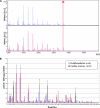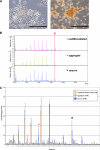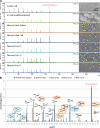Threshold in stage-specific embryonic glycotypes uncovered by a full portrait of dynamic N-glycan expression during cell differentiation
- PMID: 20008832
- PMCID: PMC2849713
- DOI: 10.1074/mcp.M900559-MCP200
Threshold in stage-specific embryonic glycotypes uncovered by a full portrait of dynamic N-glycan expression during cell differentiation
Abstract
Although various glycoforms appear to participate independently in multiple molecular interactions in cellular adhesion that contribute to embryogenesis and organogenesis, a full portrait of the glycome diversity and the effect of the structural variations of cellular glycoforms on individual cell stages in proliferation and differentiation remain unclear. Here we describe a novel concept for the characterization of dynamic glycoform alteration during cell differentiation by means of "glycoblotting-based cellular glycomics," the only method allowing for rapid and quantitative glycan analysis. We demonstrated that processes of dynamic cellular differentiation of mouse embryonic carcinoma cells, P19CL6 and P19C6, and mouse embryonic stem cells into cardiomyocytes or neural cells can be monitored and characterized quantitatively by profiling entire N-glycan structures of total cell glycoproteins. Whole N-glycans enriched and identified by the glycoblotting method (67 glycans for P19CL6, 75 glycans for P19C6, and 72 glycans for embryonic stem cells) were profiled and bar-coded quantitatively with respect to the ratio of subgroups composed of characteristic glycoforms, namely glycotypes.
Figures








References
-
- Stanton L. W., Bakre M. M. (2007) Genomic and proteomic characterization of embryonic stem cells. Curr. Opin. Chem. Biol 11, 399–404 - PubMed
-
- Kuramitsu Y., Nakamura K. (2006) Proteomic analysis of cancer tissues: shedding light on carcinogenesis and possible biomarkers. Proteomics 6, 5650–5661 - PubMed
-
- Gonnet F., Bouazza B., Millot G. A., Ziaei S., Garcia L., Butler-Browne G. S., Mouly V., Tortajada J., Danos O., Svinartchouk F. (2008) Proteome analysis of differentiating human myoblasts by dialysis-assisted two-dimensional gel electrophoresis (DAGE). Proteomics 8, 264–278 - PubMed
-
- Loring J. F., Rao M. S. (2006) Establishing standards for the characterization of human embryonic stem cell lines. Stem Cells 24, 145–150 - PubMed
Publication types
MeSH terms
Substances
LinkOut - more resources
Full Text Sources
Other Literature Sources

